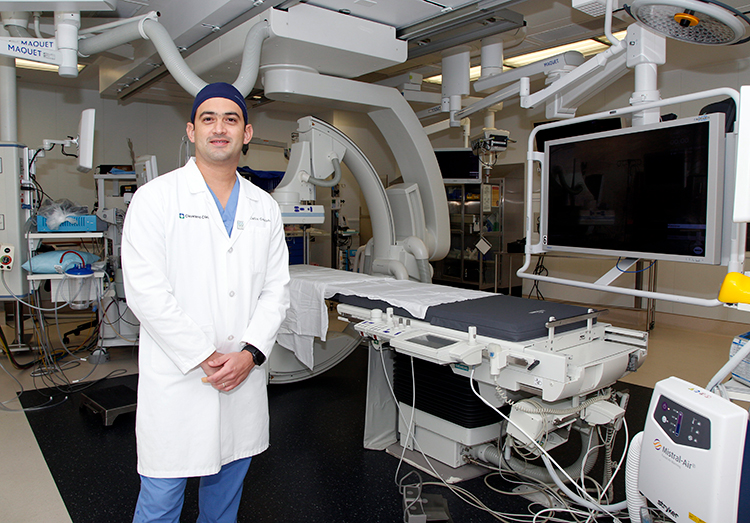
As an interventional cardiologist at Cleveland Clinic, Dr. Carlos Gonzalez is expert in catheter-based, minimally invasive treatment of structural heart disease for patients who don’t need, or fail to qualify, for open heart surgery.
One of the procedures he uses is something called transcatheter edge to edge mitral valve repair, which is used to fix damaged mitral heart valves.
“A leaky mitral valve is the most common valve problem we see,” said Dr. Gonzalez. “We use a MitraClip for transcatheter edge to edge mitral valve repair.
“There are four valves in the heart and the mitral valve is one of them. It divides the left upper chamber (atrium) from the left lower chamber (ventricle), preventing blood from going backwards. If you have a leaky mitral valve and the amount of leakage is considered severe, then it needs to be repaired. The way you know it is severe is that the patient will present a shortness of breath.
“You also have to do an echocardiogram, and if the echocardiogram shows that the leakage is severe then there are two ways that you can fix it,” said Dr. Gonzalez.
“One way is with open heart surgery, which is the gold standard to fix this problem. But some patients are too old or sick for the open-heart procedure and they simply won’t survive the surgery. For them, we now have new therapies with this mitral valve procedure to stop the leakage.”
A heart patient is usually seen by a general cardiologist first who listens to the heart, hears a murmur, and finds the leakage of the mitral valve with an echocardiogram. The patient may have experienced shortness of breath, or he may not be able to lie flat or walk.
That patient would then be referred to a cardiac surgeon and interventional cardiologist who work as a team. They review the case and determine which procedure is best for the patient.
If the patient is not a good candidate for open heart surgery, then the team will suggest the MitraClip procedure, which is done by the surgeon and interventional cardiologist working together.
“During the procedure, a miniature clip is attached to the abnormal part of the valve, closing it tightly, while the rest of the valve opens and closes normally. This prevents or minimizes the amount of regurgitation through the valve.”
According to myheart.net, the MitraClip procedure is performed through a small incision in the groin, unlike traditional mitral valve surgery that requires sawing open the breastbone. A tube is passed up through the leg vessels to the right side of the heart where the tube then passes into the left side of the heart using a technique known as transseptal puncture, a specialized technique that allows access to the mitral valve.
The MitraClip is then passed through this tube connected to a delivery system which is an instrument outside the body that allows the doctor to control the delivery of the MitraClip. The MitraClip is positioned with its arms open below the mitral valve. It is then pulled upward, and the mitral leaflets are grasped. After the clip is closed, doctors check to be sure there is a reduction in mitral leakage.
“We are working as team and communicating with each other the entire time,” Dr. Gonzalez said. “We are guided by the echocardiogram which enables us to see the heart in 3-D detail. We rely on our cardiac anesthesiologist, Dr. John Lindenthal, to show us where the leakage is so we know where to put the clip.”
Dr. Gonzalez said the MitraClip procedure reduces leakage 96 percent of the time, and it will most likely last for the rest of the patient’s life, since most of the candidates are over the age of 75. There is basically no recovery time. Patients can walk just two hours after the procedure, and after a one-night stay in the hospital they can go home and resume their daily activities.
“If you have severe leakage of the mitral valve and you don’t fix it, you will keep coming back to the hospital and eventually die,” Dr. Gonzalez said.
“While there are some risks, they are minimal compared to the benefits. The bottom line is you will live longer. We are very fortunate to have such an experienced cardiac team at Cleveland Clinic Indian River Hospital. Not long ago you would have had to travel to Orlando or West Palm for this procedure. We are proud to be able to bring this quality of cardiac care to Vero Beach.”
Dr. Gonzalez earned his medical degree at Universidad Nacional de Colombia in Bogota, Colombia, and completed his internship in Internal Medicine at Lincoln Medical and Mental Health Center in New York. He also completed fellowships in cardiovascular imaging and interventional cardiology at Icahn School of Medicine at Mount Sinai and an additional fellowship in structural heart disease at New York University School of Medicine.



